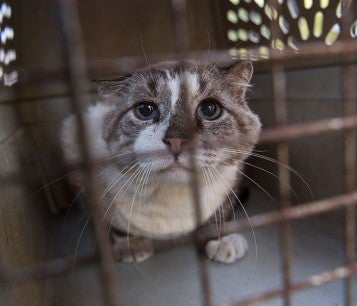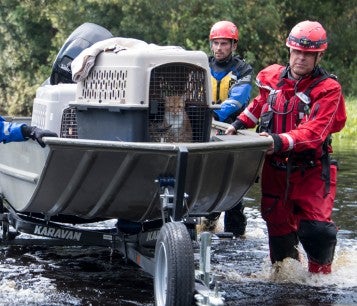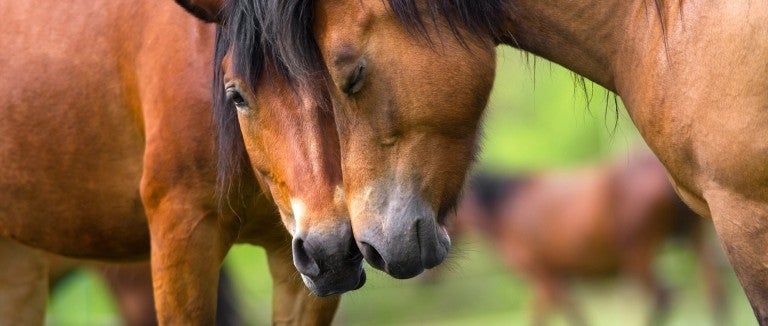Plan for your equines
Call your county and ask if they have an emergency shelter or location for animals.
Call local animal control to flag your property so it’s on the radar of emergency officials for assistance.
If you have a horse or large animal at a boarding facility or barn, ensure there is a disaster plan in place to notify owners and or provide evacuation, if necessary.
Ensure locks on barn doors are operational and easily opened in the event of an emergency.
Ensure you have enough vehicles/trailers to move the number of horses at your facility.
Permanently identify each horse by tattoo, microchip, brand or photograph. In your records, include the horse’s age, sex, breed and color. Keep this information with your important papers.
Keep halters ready for your horses. On each halter, attach a luggage tag with the following information: the horse's name, your name, email address, your telephone number and another emergency telephone number where someone can be reached. At the time of evacuation, consider additional temporary identification, such as a leg band.
Place your horses' Coggins tests, veterinary papers, identification photographs, and vital information—such as medical history, allergies and emergency telephone numbers (veterinarian, family members, etc.)—in a watertight envelope. Store the envelope with your other important papers in a safe place that will be easy for you to access, so you can take them with you when you and your horses evacuate.
Make arrangements in advance to have your horse trailered in case of an emergency. If you don’t have your own trailer or don’t have enough room in your trailer for horses, be sure you have several people on standby to help evacuate your horses. Check with local haulers for availability during emergencies. When using emergency transport by unknown haulers during the emergency, collect contact information, vehicle identification, license plate and driver’s license.
Practice loading your horses into a trailer so they become comfortable with the procedure.
Have a back-up plan in case it’s impossible to take your horse with your when you evacuate. Consider different types of disasters and whether your horses would be better off in a barn or loose in a field. Your local humane organization, agricultural extension agent, or local emergency management agency may be able to provide you with information about your community's disaster response plans.
Share your evacuation plans with friends and neighbors. Post detailed instructions in several places—including the barn office or tack room, the horse trailer, and barn entrances—to ensure emergency workers can see them in case you are not able to evacuate your horses yourself.
Prepare a basic first aid kit. Be sure to include enough water (12 to 20 gallons per day per horse), hay, feed and medications for several days for each horse.
Evacuate as soon as you can; if you wait until the last minute to evacuate, emergency management officials may tell you that you must leave your horses behind.
We never know where disasters will strike or when animals may be in need of urgent rescue, but we know we must be ready. Your support makes this lifesaving work possible.

Evacuating without your equines
If you are evacuating without your equines, let your large animals out into a paddock or corral and cut off their access to return to a barn or stall (they will naturally retreat to where they are fed or cared for, even if the structure is on fire).
In extreme danger with limited time, let your horse or large animal into a larger enclosed area that has been tamped down and is out of the line of fire. Ensure the safety of first response personnel by not allowing the horses to run free.
Remove halters. The synthetic fibers can melt on their faces and the metal rings can get hot and burn them as well. They can also get caught on something in their panic to run or injure themselves attempting to get loose.
Equines and floodwater
Floodwater is dangerous to swim through with hidden obstacles beneath the water, live electrical wires and unpredictable currents. Although horses and other livestock can swim, exhausted animals can drown. Do not attempt to swim them long distances through floodwaters. If high ground is nearby, provide them with fresh, clean water and notify emergency management of their location for rescue when the waters recede.
Learn more about our animal rescue efforts that take place during hurricanes, tornadoes, wildfires and more.

Equines and barn fires
Most barn fires are preventable and too often they result from negligence or apathy toward fire prevention. Preventing barn fires and being prepared in the event of a fire can mean the difference between life and death for your livestock. Knowledge of the danger of fires and how to deal with them is essential, and vigilance is key to prevention.
How to prevent a barn fire
- Prohibit smoking in or around the barn. A discarded cigarette can ignite dry bedding or hay in seconds.
- Avoid parking tractors and vehicles in or near the barn. Engine heat and backfires can spark a flame.
- Store other machinery and flammable materials outside the barn.
- Inspect electrical systems regularly and immediately correct any problems. Rodents can chew on electrical wiring and cause damage that quickly becomes a fire hazard.
- Keep appliances to a minimum in the barn. Use stall fans, space heaters and radios only when someone is in the barn.
- Be sure hay is dry before storing it. Hay that is too moist may spontaneously combust. Store hay outside the barn in a dry, covered area when possible.
- Reinforce your house, barn and outbuildings with hurricane straps and other measures. Perform regular safety checks on all utilities, buildings and facilities on your farm.
- Use only native and deep-rooted plants and trees in landscaping (non-native plants are less durable and hardy in your climate and may become dislodged by high winds or broken by ice and snow).
- Remove all barbed wire, and consider rerouting permanent fencing so that animals may move to high ground in a flood and to low-lying areas during high winds.
- Install a hand pump and obtain enough large containers to water your animals for at least a week (municipal water supplies and wells are often contaminated during a disaster).
- Identify alternate water and power sources. A generator with a safely stored supply of fuel may be essential, especially if you have electrical equipment necessary to the well-being of your animals.
- Secure or remove anything that could become blowing debris; make a habit of securing trailers, propane tanks and other large objects. If you have boats, feed troughs or other large containers, fill them with water before any high wind event. This prevents them from blowing around and gives you an additional supply of water.
- If you use heat lamps or other electrical machinery, make sure the wiring is safe and that any heat source is clear of flammable debris.
- Label hazardous materials and place them all in the same safe area. Provide local fire and rescue and emergency management authorities with information about the location of any hazardous materials on your property.
- Remove old, buried trash, which is a potential source of hazardous materials during flooding that may leach into crops, feed supplies, water sources and pasture.
What to do in the event of a barn fire
- Immediately call 911 or your local emergency services.
- Do not enter the barn if it is already engulfed in flames.
- If it is safe for you to enter the barn, evacuate animals one at a time, starting with the most accessible ones.
- Never let animals loose in an area where they are able to return to the barn.
- Put a halter and lead rope on each horse when you open the stall door. Be aware that horses tend to run back into burning barns out of fear and confusion.
- Blindfold horses only if absolutely necessary. Many horses will balk at a blindfold, making evacuation more difficult and time consuming.
- Move horses to paddocks close enough to reach quickly but far enough from the barn that they won't be affected by the fire and smoke.
- Be sure to have all your horses checked by a veterinarian after the fire. Smoke inhalation can cause serious lung damage and respiratory complications. Horses are prone to stress and may experience colic after a fire.
Additional resources
- Pet disaster preparedness: Prevent tragedy by preparing for a disaster or everyday emergency before it happens
- Livestock disaster preparedness: Be prepared in the event of an emergency
- Community cat disaster preparedness: You can help community (feral and stray) cats before and after a hurricane, earthquake, flood or other disasters
- Wildlife disaster preparedness: You can give wild animals a helping hand during extreme weather
